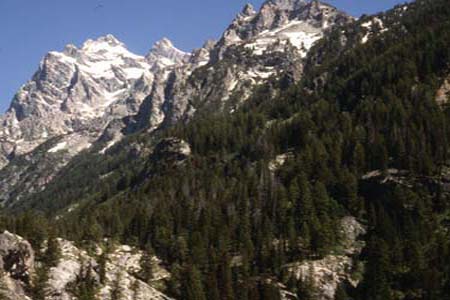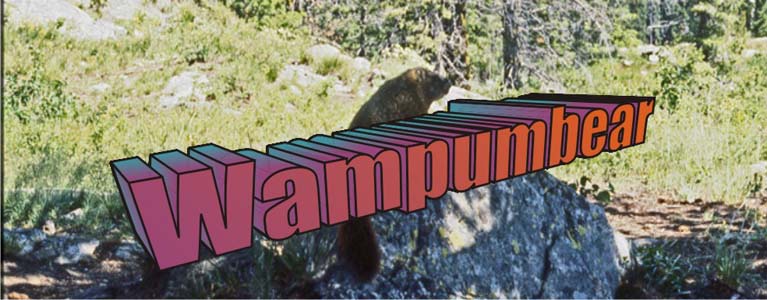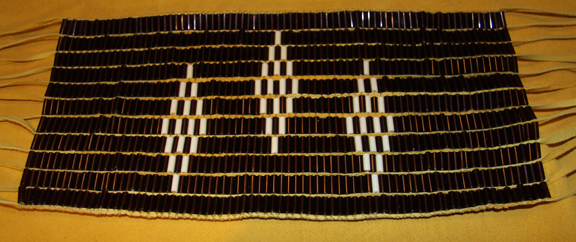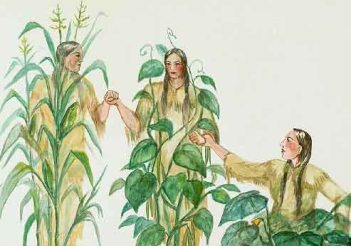 |
 |
 |
Photographs (left to right): Tetons, Wyoming; Capitol Reef National Park, Utah; Anza Borrego Desert, California
Wampum Belt Archive
Three Sisters

April 21 2015
Original Size: |
Beaded Length 12.0. Width 6.5 inches. Width w/fringe: 22.0 inches. |
Beads: |
Columns: 77. Rows: 11. Total Beads: 847. |
Materials: |
Warp: Deer Leather. Weft: Artificial Sinew. Beads: Glass |
Description:
Original design by R Hamell 01/12/19. Inspired by the story of the Haudenosaunee Three Sisters. The story is told by the Oneida to whom I give my appreciation to have it reproduced here. http://www.oneidaindiannation.com/the-legend-of-the-three-sisters/
The Legend of the Three Sisters

unknown artist
There are several legends surrounding the Three Sisters; indeed, almost every American Indian nation seems to have its own. The Cherokee legend involves three women who helped each other stay fed, hydrated and strong on the Trail of Tears, a lesson that the Cherokee used in planting their crops when they arrived in the Oklahoma Territory. Another legend describes three sisters who bickered constantly until their mother gave each of them an egg cooked in a different way and showed the sisters that, although the textures of the eggs were different, they were still eggs.
This is one version of the Haudenosaunee legend of the Three Sisters:
Very long ago, there were three sisters who lived in a field. The youngest was so small she could not yet walk; she crawled along the ground, dressed in green. The middle sister wore a bright yellow dress and darted back and forth across the field. The eldest sister stood tall and straight, and her body bent with the wind. She had long yellow hair and wore a green shawl. The three sisters loved one another very much and could not imagine living without the others.
One day a little Indian boy came to the field. He was very handsome and knew the ways of the land. He could talk with the birds and the animals and was straight and fearless. The three sisters were very interested in this boy as they watched him use his stone knife to carve a bowl or hunt with his bow and arrow.
Late in the summer of the boy’s first visit to the field, the youngest of the three sisters disappeared. She was the one who could only creep along the ground; she could not even stand unless there was a stick she could cling to. But she was gone, and the other two sisters mourned her until the fall.
The Indian boy returned to the field to gather reeds that grew at the edge of a small stream. He used the reeds to make arrow shafts. The two remaining sisters again watched him, fascinated. That night, the second sister disappeared, the one who always wandered hither and yon.
Now there was only one sister left, the tall and straight sister. She did not bow her head in sorrow, though she mourned deeply and thought she could not live in the field alone without her sisters. As the days grew shorter and colder, her green shawl began to lose its color and her yellow hair became dry and tangled. Night and day she sighed for her sisters, but her voice was low like the wind, and no one heard her.
One day in the harvest season, the little Indian boy heard the third sister crying, and he felt sorry for her. He took her in his arms and carried her to his home, and there a delightful surprise awaited her: Her sisters were there in the lodge, safe and very glad to be reunited. They explained that they had been curious about the little Indian boy and had followed him home, and they had decided to stay because winter was coming and his home was warm and comfortable.
The sisters also were making themselves useful to the boy and his family. The youngest, now all grown up, kept the dinner pot full, while the second sister, still in her yellow dress, dried herself on the shelf so she could fill the dinner pot later in the winter. The eldest sister was so pleased to be with her sisters again and so impressed with the help they gave the boy that she too began drying herself so the family would have meal to use as the winter went on.
And from that day to this, the three sisters were never separated again.
Reference:
“The Three Sisters – Exploring an Iroquois Garden,” Cornell Cooperative Extension, 1997.
 |
 |
 |
 |
 |
 |
 |
 |
|---|
